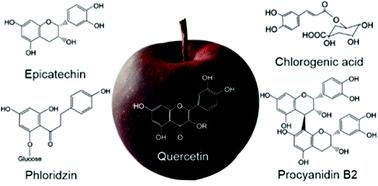当前位置:
X-MOL 学术
›
Food Funct.
›
论文详情
Our official English website, www.x-mol.net, welcomes your feedback! (Note: you will need to create a separate account there.)
Phenolic composition of 91 Australian apple varieties: towards understanding their health attributes.
Food & Function ( IF 6.1 ) Pub Date : 2020-07-29 , DOI: 10.1039/d0fo01130d Catherine P Bondonno 1 , Nicola P Bondonno 2 , Sujata Shinde 3 , Armaghan Shafaei 4 , Mary C Boyce 4 , Ewald Swinny 5 , Steele R Jacob 6 , Kevin Lacey 6 , Richard J Woodman 7 , Kevin D Croft 3 , Michael J Considine 8 , Jonathan M Hodgson 1
Food & Function ( IF 6.1 ) Pub Date : 2020-07-29 , DOI: 10.1039/d0fo01130d Catherine P Bondonno 1 , Nicola P Bondonno 2 , Sujata Shinde 3 , Armaghan Shafaei 4 , Mary C Boyce 4 , Ewald Swinny 5 , Steele R Jacob 6 , Kevin Lacey 6 , Richard J Woodman 7 , Kevin D Croft 3 , Michael J Considine 8 , Jonathan M Hodgson 1
Affiliation

|
Introduction: Apples, an important contributor to total dietary phenolic intake, are associated with cardiovascular health benefits. Determining the phenolic composition of apples, their individual variation across varieties, and the phenolic compounds present in plasma after apple consumption is integral to understanding the effects of apple phenolics on cardiovascular health. Methods: Using liquid chromatography we quantified five important polyphenols and one phenolic acid with potential health benefits: quercetin glycosides, (−)-epicatechin, procyanidin B2, phloridzin, anthocyanins, and chlorogenic acid, in the skin and flesh of 19 apple varieties and 72 breeding selections from the Australian National Apple Breeding program. Furthermore, we measured the phenolic compounds in the plasma of 30 individuals post-consumption of an identified phenolic-rich apple, Cripp's Pink. Results: Considerable variation in concentration of phenolic compounds was found between genotypes: quercetin (mean ± SD: 16.1 ± 5.9, range: 5.8–30.1 mg per 100 g); (−)-epicatechin (mean ± SD: 8.6 ± 5.8, range: 0.2–19.8 mg per 100 g); procyanidin B2 (mean ± SD: 11.5 ± 6.6, range: 0.5–26.5 mg per 100 g); phloridzin (mean ± SD: 1.1 ± 0.6, range: 0.3–4.3 mg per 100 g); anthocyanins (mean ± SD: 1.8 ± 4.4, range: 0–40.8 mg per 100 g); and chlorogenic acid (mean ± SD: 11.3 ± 9.9, range: 0.4–56.0 mg per 100 g). All phenolic compounds except chlorogenic acid were more concentrated in the skin compared with flesh. We observed a significant increase, with wide variation, in 14 phenolic compounds in plasma post-consumption of a phenolic-rich apple. Conclusion: This information makes an important contribution to understanding the potential health benefits of apples.
中文翻译:

91个澳大利亚苹果品种的酚类成分:了解其健康属性。
简介:苹果是膳食中酚类总摄入量的重要贡献者,与心血管健康相关。确定苹果的酚类成分,各个品种之间的个体差异以及食用苹果后血浆中存在的酚类化合物对于了解苹果酚类化合物对心血管健康的影响至关重要。方法:使用液相色谱法,我们对19个苹果品种和72个育种品种的果皮和果肉中五种重要的多酚和一种对人体健康有帮助的酚酸进行了定量:槲皮素糖苷,(-)-表儿茶素,原花青素B2,Phloridzin,花色苷和绿原酸澳大利亚国家苹果育种计划的精选。此外,我们在食用了确定的富含酚的苹果Cripp's Pink后,测量了30个人血浆中的酚类化合物。结果:在不同基因型之间发现酚类化合物的浓度存在很大差异:槲皮素(平均值±标准偏差:16.1±5.9,范围:每100克5.8–30.1毫克);(-)-表儿茶素(平均值±SD:8.6±5.8,范围:每100克0.2-19.8毫克);原花青素B2(平均值±SD:11.5±6.6,范围:每100克0.5-26.5毫克);phloridzin(平均值±SD:1.1±0.6,范围:每100克0.3-4.3毫克);花青素(平均值±SD:1.8±4.4,范围:每100克0-40.8毫克);和绿原酸(平均值±SD:11.3±9.9,范围:每100克0.4-56.0毫克)。与皮肤相比,除绿原酸外的所有酚类化合物在皮肤中的浓度都更高。我们观察到富含酚类的苹果血浆中14种酚类化合物的血浆摄入量显着增加,差异很大。结论:此信息对理解苹果的潜在健康益处做出了重要贡献。
更新日期:2020-08-19
中文翻译:

91个澳大利亚苹果品种的酚类成分:了解其健康属性。
简介:苹果是膳食中酚类总摄入量的重要贡献者,与心血管健康相关。确定苹果的酚类成分,各个品种之间的个体差异以及食用苹果后血浆中存在的酚类化合物对于了解苹果酚类化合物对心血管健康的影响至关重要。方法:使用液相色谱法,我们对19个苹果品种和72个育种品种的果皮和果肉中五种重要的多酚和一种对人体健康有帮助的酚酸进行了定量:槲皮素糖苷,(-)-表儿茶素,原花青素B2,Phloridzin,花色苷和绿原酸澳大利亚国家苹果育种计划的精选。此外,我们在食用了确定的富含酚的苹果Cripp's Pink后,测量了30个人血浆中的酚类化合物。结果:在不同基因型之间发现酚类化合物的浓度存在很大差异:槲皮素(平均值±标准偏差:16.1±5.9,范围:每100克5.8–30.1毫克);(-)-表儿茶素(平均值±SD:8.6±5.8,范围:每100克0.2-19.8毫克);原花青素B2(平均值±SD:11.5±6.6,范围:每100克0.5-26.5毫克);phloridzin(平均值±SD:1.1±0.6,范围:每100克0.3-4.3毫克);花青素(平均值±SD:1.8±4.4,范围:每100克0-40.8毫克);和绿原酸(平均值±SD:11.3±9.9,范围:每100克0.4-56.0毫克)。与皮肤相比,除绿原酸外的所有酚类化合物在皮肤中的浓度都更高。我们观察到富含酚类的苹果血浆中14种酚类化合物的血浆摄入量显着增加,差异很大。结论:此信息对理解苹果的潜在健康益处做出了重要贡献。



























 京公网安备 11010802027423号
京公网安备 11010802027423号